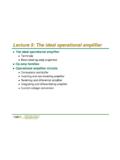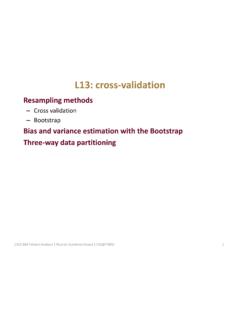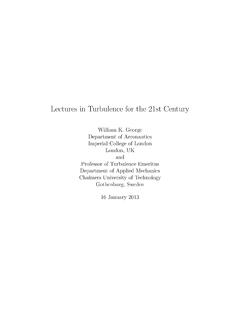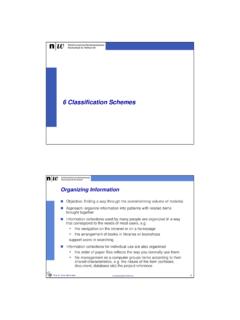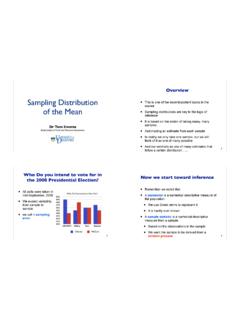Transcription of Lecture 9: Introduction to Pattern Analysis
1 Lecture 9: Introduction to Pattern Analysis g Features, patterns and classifiers g Components of a PR system g An example g Probability definitions g Bayes Theorem g Gaussian densities Intelligent Sensor Systems 1. Ricardo Gutierrez-Osuna Wright State University Features, patterns and classifiers g Feature n Feature is any distinctive aspect, quality or characteristic g Features may be symbolic ( , color) or numeric ( , height). n The combination of d features is represented as a d-dimensional column vector called a feature vector g The d-dimensional space defined by the feature vector is called feature space g Objects are represented as points in feature space. This representation is called a scatter plot x3. Feature 2. x1 Class 1. x Class 3. x = 2 . x .. x d . x1 x2. Class 2. Feature 1. Feature vector Feature space (3D) Scatter plot (2D).
2 Intelligent Sensor Systems 2. Ricardo Gutierrez-Osuna Wright State University Features, patterns and classifiers g Pattern n Pattern is a composite of traits or features characteristic of an individual n In classification, a Pattern is a pair of variables {x, } where g x is a collection of observations or features (feature vector). g is the concept behind the observation (label). g What makes a good feature vector? n The quality of a feature vector is related to its ability to discriminate examples from different classes g Examples from the same class should have similar feature values g Examples from different classes have different feature values Good features Bad features Intelligent Sensor Systems 3. Ricardo Gutierrez-Osuna Wright State University Features, patterns and classifiers g More feature properties Linear separability Non-linear separability Multi-modal Highly correlated features g Classifiers n The goal of a classifier is to partition feature space into class-labeled decision regions n Borders between decision regions are called decision boundaries R1.
3 R1. R2 R3. R2. R3. R4. Intelligent Sensor Systems 4. Ricardo Gutierrez-Osuna Wright State University Components of a Pattern rec. system g A typical Pattern recognition system contains n A sensor n A preprocessing mechanism n A feature extraction mechanism (manual or automated). n A classification or description algorithm n A set of examples (training set) already classified or described Feedback / Adaptation Classification Class algorithm assignment Preprocessing Feature The Clustering Cluster Sensor and real world extraction algorithm assignment enhancement Regression Predicted algorithm variable(s). Intelligent Sensor Systems 5. Ricardo Gutierrez-Osuna Wright State University An example g Consider the following scenario*. n A fish processing plan wants to automate the process of sorting incoming fish according to species (salmon or sea bass).
4 N The automation system consists of g a conveyor belt for incoming products g two conveyor belts for sorted products g a pick-and-place robotic arm g a vision system with an overhead CCD camera g a computer to analyze images and control the robot arm CCD. camera Conveyor belt (salmon). computer Conveyor belt Robot arm Conveyor belt (bass). *Adapted from Duda, Hart and Stork, Pattern Classification, 2nd Ed. Intelligent Sensor Systems 6. Ricardo Gutierrez-Osuna Wright State University An example g Sensor n The camera captures an image as a new fish enters the sorting area g Preprocessing n Adjustments for average intensity levels n Segmentation to separate fish from background g Feature Extraction n Suppose we know that, on the average, sea bass is larger than salmon g Classification Decision n Collect a set of examples from both species count boundary g Plot a distribution of lengths for both classes n Determine a decision boundary (threshold) that Salmon Sea bass minimizes the classification error g We estimate the system's probability of error and obtain a discouraging result of 40%.
5 N What is next? length Intelligent Sensor Systems 7. Ricardo Gutierrez-Osuna Wright State University An example g Improving the performance of our PR system n Committed to achieve a recognition rate of 95%, we try a number of features g Width, Area, Position of the eyes g only to find out that these features contain no discriminatory information n Finally we find a good feature: average intensity of the scales Decision count boundary Sea bass Salmon Avg. scale intensity length Decision boundary n We combine length and average intensity of the scales to improve class separability n We compute a linear discriminant function to separate the two classes, and obtain a classification rate of Sea bass Salmon Avg. scale intensity Intelligent Sensor Systems 8. Ricardo Gutierrez-Osuna Wright State University An example g Cost Versus Classification rate n Is classification rate the best objective function for this problem?
6 G The cost of misclassifying salmon as sea bass is that the end customer will occasionally find a tasty piece of salmon when he purchases sea bass g The cost of misclassifying sea bass as salmon is a customer upset when he finds a piece of sea bass purchased at the price of salmon n We could intuitively shift the decision boundary to minimize an alternative cost function New length length Decision boundary Decision boundary Sea bass Salmon Sea bass Salmon Avg. scale intensity Avg. scale intensity Intelligent Sensor Systems 9. Ricardo Gutierrez-Osuna Wright State University An example g The issue of generalization n The recognition rate of our linear classifier ( ) met the design specs, but we still think we can improve the performance of the system g We then design an artificial neural length network with five hidden layers, a combination of logistic and hyperbolic tangent activation functions, train it with the Levenberg-Marquardt algorithm and obtain an impressive classification rate of with the following decision boundary Sea bass Salmon Avg.
7 Scale intensity n Satisfied with our classifier, we integrate the system and deploy it to the fish processing plant g A few days later the plant manager calls to complain that the system is misclassifying an average of 25% of the fish g What went wrong? Intelligent Sensor Systems 10. Ricardo Gutierrez-Osuna Wright State University Review of probability theory g Probability n Probabilities are numbers assigned to events that indicate how likely it is that the event will occur when a random experiment is performed Sample space probability A2. A1 Probability Law A3 A1 A2 A3 A4 event A4. g Conditional Probability n If A and B are two events, the probability of event A when we already know that event B has occurred P[A|B] is defined by the relation P[A I B]. P[A | B] = for P[B] > 0. P[B]. g P[A|B] is read as the conditional probability of A conditioned on B , or simply the probability of A given B.
8 Intelligent Sensor Systems 11. Ricardo Gutierrez-Osuna Wright State University Review of probability theory g Conditional probability: graphical interpretation S S. A A B B B has A A B B. occurred . g Theorem of Total Probability n Let B1, B2, , BN be mutually exclusive events, then N. P[A] = P[A | B1 ]P[B1 ] + ..P[A | BN ]P[B N ] = P[A | Bk ]P[B k ]. k =1. B3. B1 BN-1. A. B2 BN. Intelligent Sensor Systems 12. Ricardo Gutierrez-Osuna Wright State University Review of probability theory g Bayes Theorem n Given B1, B2, , BN, a partition of the sample space S. Suppose that event A occurs; what is the probability of event Bj? n Using the definition of conditional probability and the Theorem of total probability we obtain P[A I B j ] P[A | B j ] P[B j ]. P[B j | A] = = N. P[A | B ] P[B. P[A]. k k ]. k =1.
9 N Bayes Theorem is definitely the fundamental relationship in Statistical Pattern Recognition Rev. Thomas Bayes (1702-1761). Intelligent Sensor Systems 13. Ricardo Gutierrez-Osuna Wright State University Review of probability theory g For Pattern recognition, Bayes Theorem can be expressed as P(x | j ) P( j ) P(x | j ) P( j ). P( j | x) = N. =. P(x | k ) P( k ). P(x). k =1. n where j is the ith class and x is the feature vector g Each term in the Bayes Theorem has a special name, which you should be familiar with n P( i) Prior probability (of class i). n P( i|x) Posterior Probability (of class i given the observation x). n P(x| i) Likelihood (conditional prob. of x given class i). n P(x) A normalization constant that does not affect the decision g Two commonly used decision rules are n Maximum A Posteriori (MAP): choose the class i with highest P( i|x).
10 N Maximum Likelihood (ML): choose the class i with highest P(x| i). g ML and MAP are equivalent for non-informative priors (P( i)=constant). Intelligent Sensor Systems 14. Ricardo Gutierrez-Osuna Wright State University Review of probability theory g Characterizing features/vectors n Complete: Probability mass/density function 1. 1. 5/6. pdf 4/6. pmf 3/6. 2/6. 1/6. 100 200 300 x(lb). 400 500. 1 2 3 4 5 6 x pdf for a person's weight pmf for rolling a (fair) dice n Partial: Statistics g Expectation n The expectation represents the center of mass of a density g Variance n The variance represents the spread about the mean g Covariance (only for random vectors). n The tendency of each pair of features to vary together, , to co-vary Intelligent Sensor Systems 15. Ricardo Gutierrez-Osuna Wright State University Review of probability theory g The covariance matrix (cont.)


